Arai Tour-X5 helmet review
Published on: 20 December 2023
CLICK ARAI TOUR-X5 HELMET TO SHOP WITH FREE UK NEXT DAY DELIVERY
The Tour-X4 was a famous helmet. It pretty much owned what one might call the 'adventure' space. Interestingly, it owned the category even before the term 'adventure riding' was invented. Without doubt the newly launched Arai Tour-X5 will now claim top dog status amongst adventure helmets. Available in a number of plain colours (Diamond black, white, grey and a lovely Mojave Sage which is exclusive to Motolegends) as well as the hugely popular Cosmic blue graphic.
An adventure helmet is different to an off-road helmet. And this is what Arai recognised when it first introduced the Tour-X concept. What they realised was that a lot of people simply like riding on the road on a bike that looks like it was designed for riding off it. Arguably, the bike that kicked it all off was the original BMW R80 GS back in the eighties. This was the bike that won the Paris Dakar; and more than once. Here was a bike you could tour the world on. But equally this was a bike you could just as easily commute into work on. If you were going to ride such a bike, you probably didn't want a proper, lightweight, off-road helmet. Nor did you want a sports helmet. What you wanted was a helmet that looked like an off-road helmet, but that would brook few compromises on the road. That’s what the original Tour-X concept was all about. It still is!
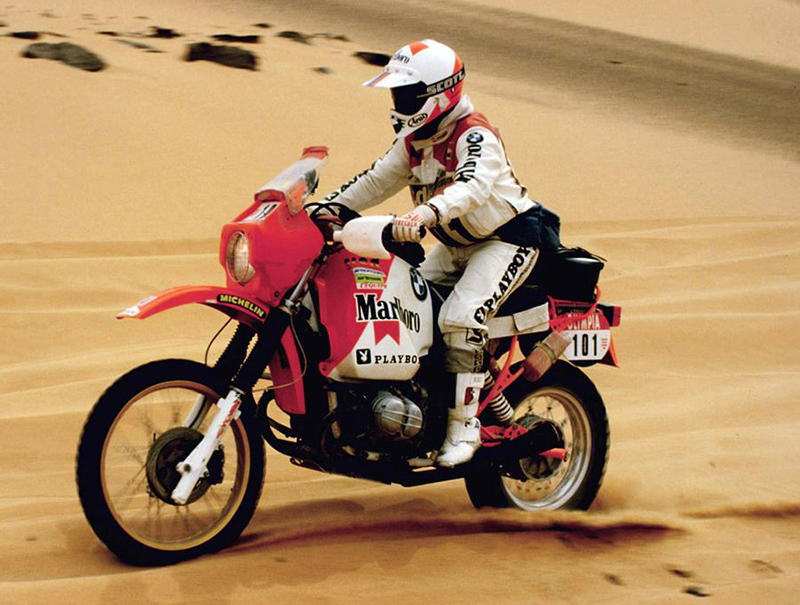
The Tour-X4 was, in truth, starting to look a little long in the tooth. It had been in the market, pretty much unchanged, since 2012. And in helmet years that's a long time. Who knows why Arai left it unchanged for so long? As the market leader in this sector, they perhaps saw little reason to mess with a winning formula, but whatever the thinking ECE 22-06 provided the opportunity to go back to the drawing board.
Not that the Tour-X5 is a markedly different helmet. It is, however, in almost every respect, a new helmet. There are very, very few components that the two helmets have in common. But the principles and the ethos behind the Tour-X5 are identical to those of its predecessor.

This review is about the Tour-X5, but one of the reasons that the Tour-X4 was so highly rated relates to the fact that it was, of course, an Arai.
On pretty much any objective analysis, Arai makes the world's best quality, safest and most protective helmets. This is a company that doesn't just pay lip service to safety and protection. This is a company that is obsessed with safety and protection.
Along with Shoei, Arai sets the bar. Since the 1960s, the two companies have totally dominated motorcycle racing. More recently, they basically shaped the FIM standard for Moto GP; a standard that then set the benchmark for ECE 22-06. But, rightly or wrongly, and unlike Shoei, Arai has eschewed many of the developments that a lot of riders have come to consider as mandatory when they choose a new helmet. Arai will not countenance a drop-down, sun visor, for example. They will not contemplate a flip-up chin bar. They will not even design a helmet to incorporate a comms. system.
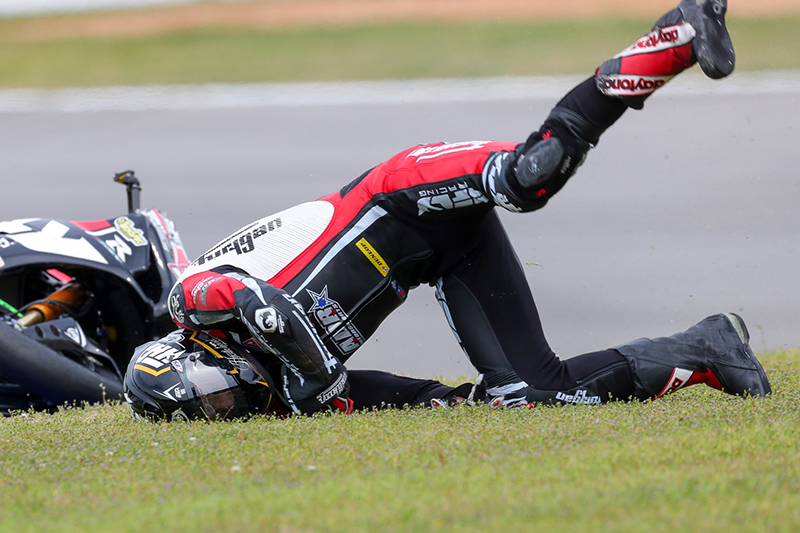
They have done this on safety grounds, and in the full knowledge that their refusal to bend to market forces costs them millions of pounds annually in sales. That has to be admired. Of course, compromise is always present in motorcycling, so many of us take the view that the advantages of drop-down visors, flip-up chin bars and built-in comms. outweigh the disadvantages. We are not, after all, Moto GP riders. Whatever some people say, kitting ourselves out for the bike is never solely about protection at the expense of everything else.
But for Arai it is. Remember, this is the company that invented the eps liner that forms the energy-absorbing component in just about every helmet out there. Everybody has heard about Arai's pre-occupation with what they call 'glancing off'. And intuitively we can all understand what it is. It's about allowing a helmet to slide, skip or bounce off hard surfaces, thereby reducing the direct force of an impact.
But Arai's position is not just a theoretical one. What they are aware of from racing is that, at high speed, the kinetic forces that can be generated through a helmet when our head hits something are way, way beyond those that can be absorbed by the shell and eps of any helmet. And so this is why they are always looking to make incremental improvements to their shells and liners; and why they try so hard to ensure that their helmets will bounce and slide on impact rather than dig in.
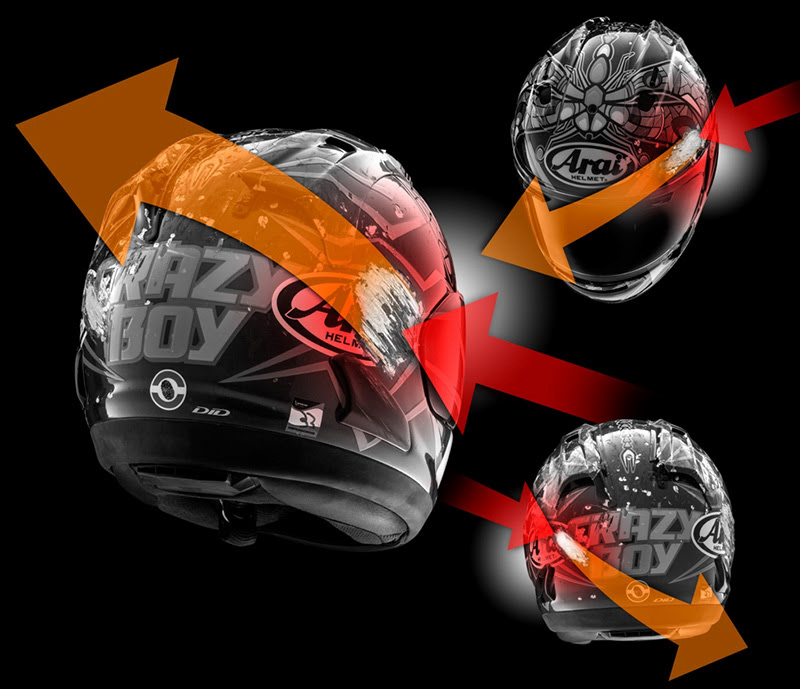
Not of course that this is where Arai’s quest for added safety ends. Arai always tests its helmets to a standard that exceeds the mandatory ones. The company tests all its shells for resistance to puncturing, for example. It’s a test that still doesn’t form part of 22-06.
Nevertheless, it has to be said that Arais are not for everybody. They won't fit everybody. For some they may be too heavy. For some they may be too noisy. For a lot of riders they will simply be unaffordable. And, of course, many of us have come to value those conveniences that Arai will never offer.
But if safety and protection really were your only concerns you would only ever wear an Arai. And of course what always has to be borne in mind is what a helmet is protecting. Essentially, the brain. And brain damage can never be repaired, however long you spend in hospital. The best we can ever do is learn how to cope with the damage. It's a sobering thought that causes one to wonder whether here, more than in any other area of motorcycle wear, it is sensible to make economies!
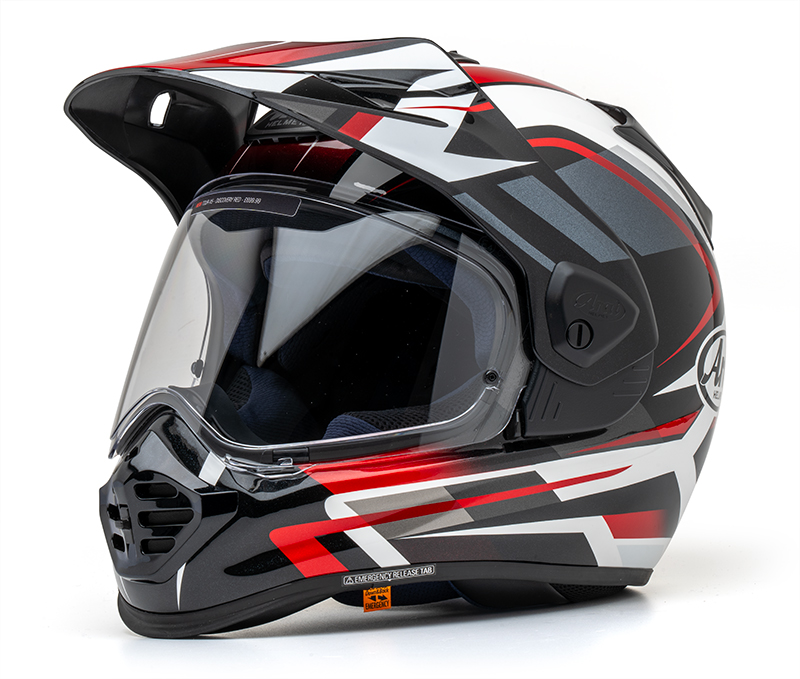
As we have suggested, the Tour-X5 is more about evolution than revolution. But the area where there is probably the clearest blue water is ECE 22-06. The new standard is simply more stringent than the old one. Of course, it may be that Arai has had to work less hard on meeting the new standard than some manufacturers, but the fact is that, even with Arai, one can be reasonably confident that the 22-06 Tour-X will be more protective than the 22-05 one that came out in 2012.

Under 22-06, a shell has to absorb a much increased impact force. A force that is now measured at many different points on the shell. There is now also an official 'angled impact’ test. There are now tests for the rigidity of the shell. For the strength of the visor. And much more besides.
The shell on the X5 is made in the same way as pretty much all Arai shells. It is basically glassfibre. But these fibres are interwoven with fibres used in the aerospace industry that are 30% stronger than glassfibre. We are not going to go into too much detail here, because it is very boring, but Arai's shells are thicker and harder than those of other brands. And this goes back to the early testing that Arai did with Snell in America; a standard that was created for automotive racing where harder shells are called for to cope with the kind of multiple impacts that can result from repeated contacts with a roll cage.
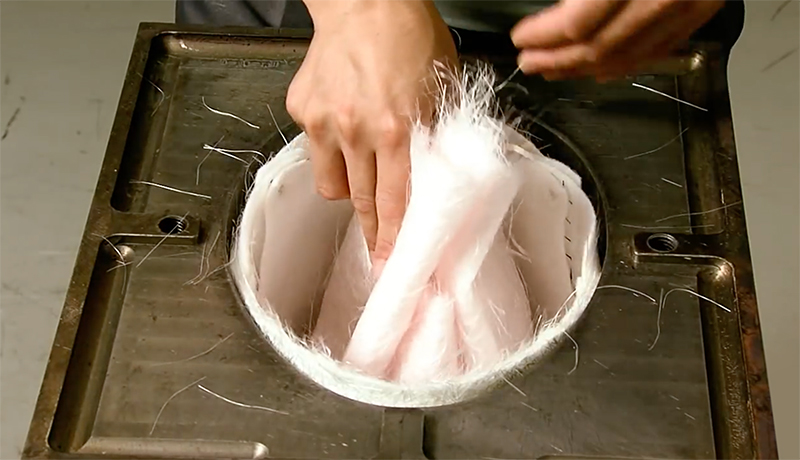
Because Arais have harder shells that don't tend to absorb energy so effectively, they therefore require thicker eps liners to compensate. And this is why Arai helmets tend to be somewhat larger than other helmets, and somewhat heavier. For most people, this is not an issue. The differences are perhaps marginal. It is, however, part and parcel of an Arai.
The eps in the X5 is, of course, multi-density to reflect the need to protect us from both slow speed and high speed impacts. Arai is the only company to incorporate numerous densities into a one-piece eps. Impressive as this sounds, I am not sure that we know why, and how, this is necessarily beneficial to the rider.
With the Tour-X5, Arai talk about the helmet being easier to get on and off. And they have done this by making the helmet a little wider at its base. Well, we were not particularly aware of a problem with the previous model. All we do know is that the larger the base of a helmet the greater is the likelihood that air will enter the helmet. And, in our world, more air entering a helmet means more noise. Arais are rarely quiet helmets, but we cannot see this change making the Tour-X5 any quieter!
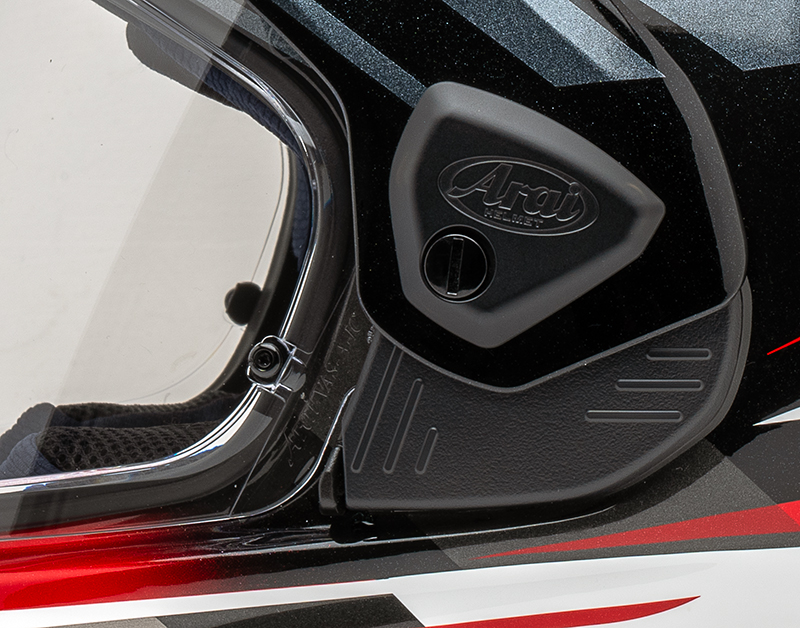
One of the biggest beefs that owners always had with the X4 was the tricky peak removal mechanism. Well the new VAS-A visor system, with its new side pads, makes the whole process of taking off, and replacing, the peak much easier. No tools are required. And so changing the visor, say for a dark one, is a piece of cake. It takes two seconds.
But if you want to ride the helmet without a peak, as a road helmet, it’s still a bit fiddly, because you then have to unscrew the side plates that are attached to the peak, and screw them back onto the helmet. It’s not rocket science, but it still took me ten minutes to work out how to do it. You will need a flat headed screwdriver to do it. Even better a dinner knife with a rounded edge. Best of all a penny!
Bottom line? This still isn't the most intuitive and straightforward peak and visor removal system we have come across. Other brands make it easier, but with those other brands you don’t get, of course, many of the other things you get with the Tour-X5!
The visor aperture on the new helmet is quite a bit larger than the X4’s, and therefore so is the visor itself. That's got to be good for visibility, but with a nose that is less ‘pointy’ the visor is also flatter. Arai has changed the front profile of the helmet, apparently, to once again improve its glancing off properties. But one of the upsides is less distortion in the visor, and better optical quality. The flatter shape should also allow the Pinlock to sit better; sometimes a problem with the X4.
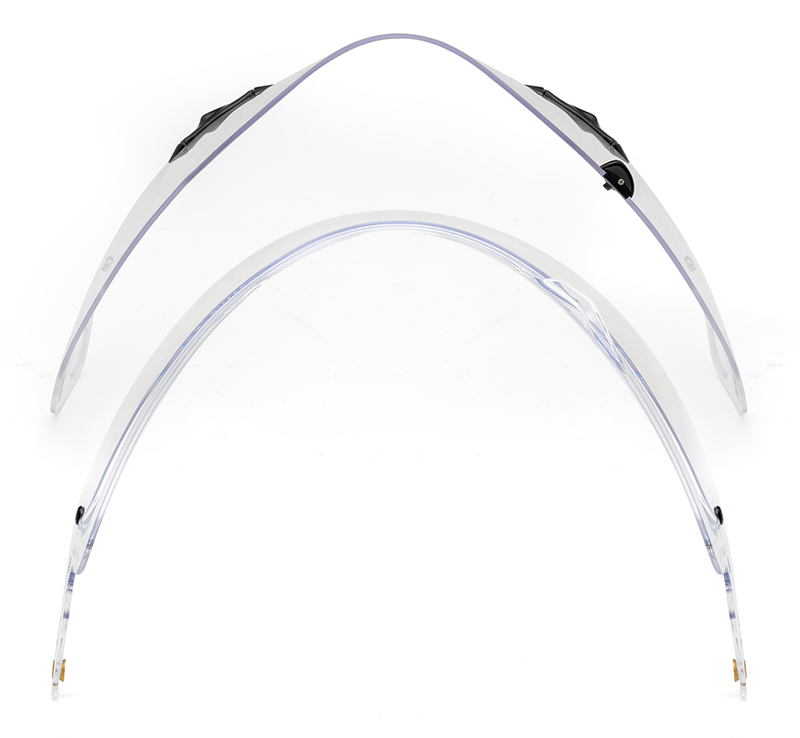
Out of interest, the Pinlock that comes with the helmet is a 120 MaxVision. MaxVision Pinlocks are larger, and are designed to cover almost the entire area of the outer visor. And this is a good thing. But the Pinlock insert is also what is known as an XLT Pinlock. In essence, all 120 Pinlocks inserts will eventually become XLT. And whilst XLT stands for 'Extra Light Transmission', the main property of an XLT insert is simply greater visual clarity.
It is the peak, of course, that is the distinguishing feature of an adventure helmet. Some contend that a peak was originally all about preventing mud from the bike in front splattering the visor. Some contend that its most useful function is blocking out the low sun. Of course, equally, some suggest that, on a road helmet, a peak is little more than a styling flourish.
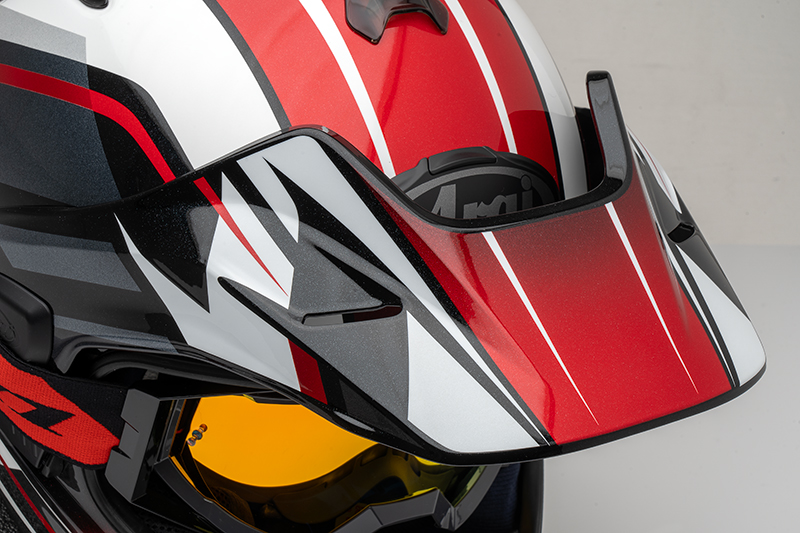
But what cannot be denied is that a peak can cause problems, especially when riding at speed. Depending upon the height of the rider, and the height of a screen, a peak can oscillate, it can cause buffeting and add strain to the neck. A peak can also create wind noise. And often there is nothing that you can do about it other than to remove the peak. And if that's what's necessary, so be it. It's not the helmet's fault. It's just one of those things. When you go for an adventure helmet, it's a potential issue that comes with the territory.
This having been said, Arai has apparently spent time in the wind tunnel to try and reduce the issues. Air will flow far more easily through the peak of the X5 than through that of the X4; and in this it's aided by a large cut out on the rear edge of the peak. The peak is adjustable, by the way. Some have suggested that the peak sits further forward than on the X4, but we don't think so; indeed this may be more a reflection of a more rounded chin area.
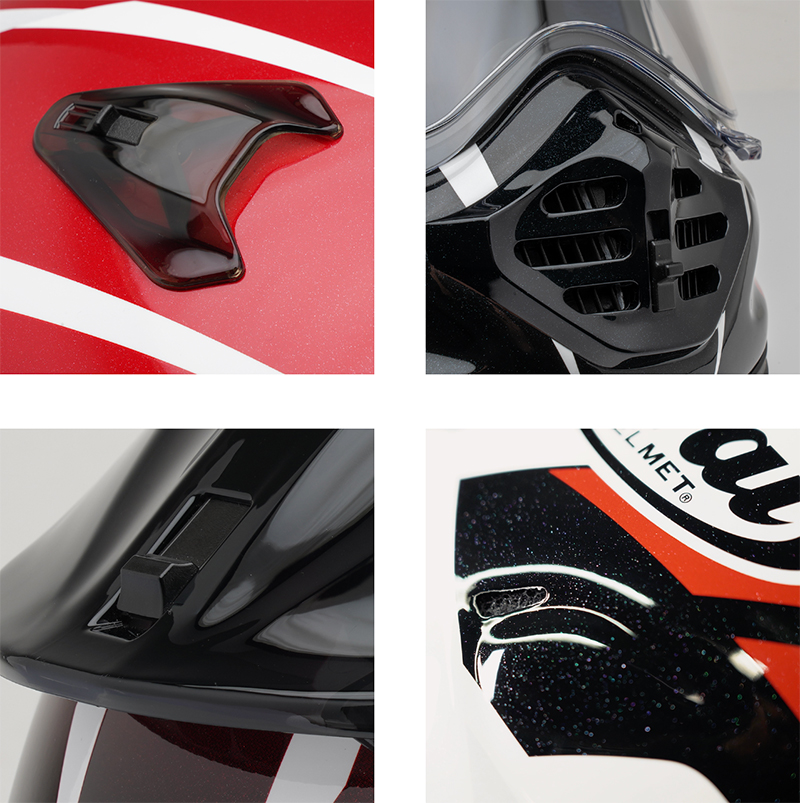
If an adventure helmet is about adventuring, working hard riding through difficult terrain, or visiting exotic locations, airflow and venting can be important. The X5 utilises the Arai logo brow vent that was first introduced on the Quantic. You also get a two-position vent on the crown of the shell. On the chin there's another two-position vent. Behind this vent, inside the helmet, there's a switch. In the 'Up' position air will be directed to the visor to help with fogging. In the down position, air will flow directly onto the face.
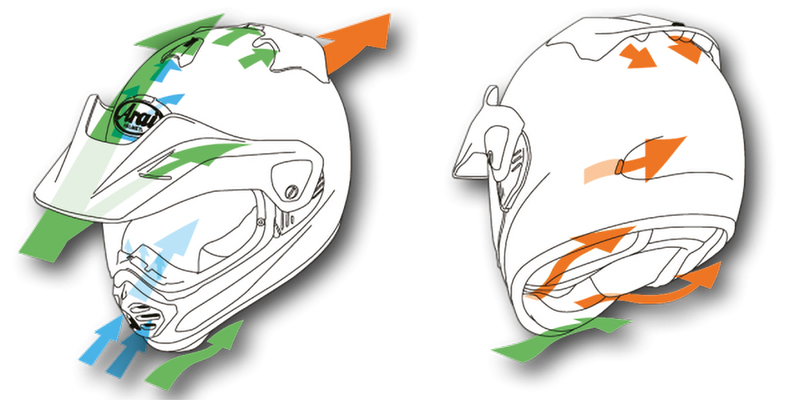
Air flows through the helmet through channels in the eps. This air can escape through two, permanently-open, small exhaust vents towards the back of the helmet, and through an adjustable exhaust vent beneath the rear spoiler. Although, in truth, nobody has ever adequately explained to us the benefits of a closable exhaust vent!
What you don’t get with the X5 are the eyebrow vents you got on the X4. Eyebrow vents are extremely effective when it comes to directing air onto the forehead. But they are also very noisy when open, which is probably why Arai removed them from the new helmet.
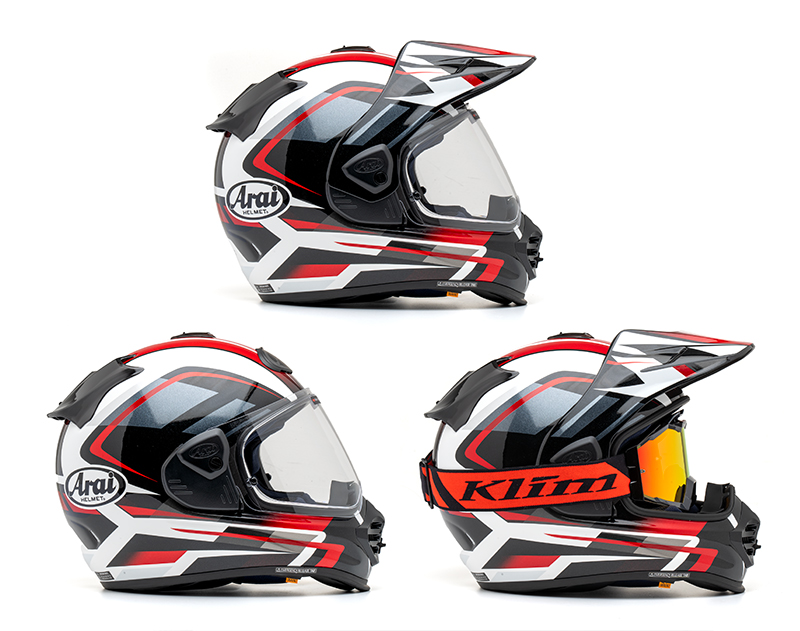
Obviously, you can ride in the X5 without the peak, and without the visor. And some people who cannot live with the buffeting of a peak, may find themselves having to resort to this. But you should not jump to the conclusion that the X5 is the last word in versatility; the helmet that can do everything. On the road, an adventure helmet is less than ideal. If you must have a peak to go with your GS, your adventure suit and buckled boots, go for it. But if most of your riding is on the road you would almost certainly be better served by a sport-touring helmet, or a flip. These helmets will come with the added utility of a drop-down sun visor. They will put less strain on your neck. And they will be quieter.
The new X5 is a little bit heavier than the X4, but only marginally so; and not such that you’d notice. Both are also a little bit heavier than the Shoei Hornet; but again not by a lot.
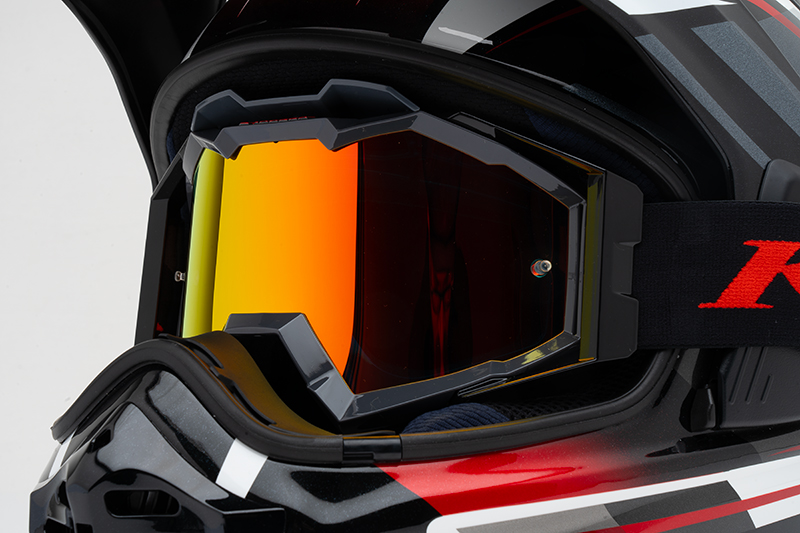
The larger visor on the X5 allows even the largest, off-road goggles to be accommodated within its aperture. Our favourite goggles are the Viper Pros from Klim. They sit perfectly in the X5, and they are the largest we have come across.
We have already mentioned that Arai will never design a helmet with an integrated comms. facility. But Arai has made some concessions with the X5. They have supposedly created a flat area allow for the mounting of a unit. (We are not convinced that this is not just a happy coincidence). They have created recesses for speakers. And there is now a channel for concealing the wiring on a comms. system. Not exactly full integration, but a step in the right direction perhaps!
The X5 has a pull-down chin curtain that is built into the chin. And this is clever. There will be times when you want a curtain, and times when you don't. It's not a chin curtain like you get with a Neotec 3, but it's very clever. In fact, the X4 had a similar arrangement, although most people never knew their helmet had it.
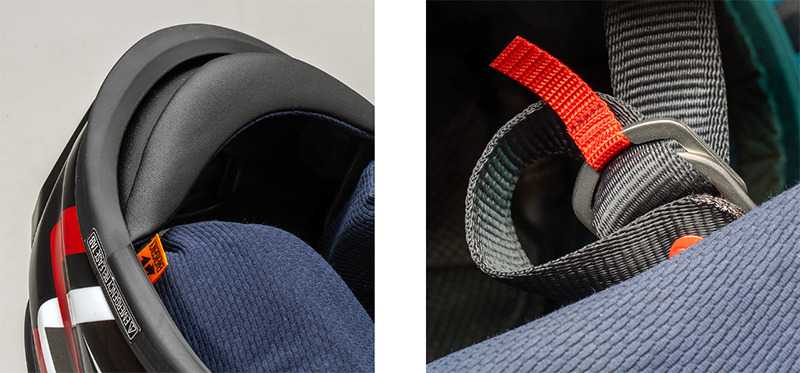
The X5, like all Arais, comes with a D-ring fastener for the chin strap. Again, there are no rights and wrongs. Some people prefer D-rings; some prefer micrometric adjusters. The emergency services prefer the latter. Arai always prefer the former. If you don't like D-rings, the X5 may not be for you.
In truth, not a lot. And in making any observations we are mindful of the fact that we have only had the one helmet in our hands; and even then not for that long.
The first point we would make is that you cannot raise the visor very high when the peak is in place. It is stopped from going further by the peak, but the problem is that if you ride with the visor up the lower edge of the visor is going to be right in the line of sight. This is, at best, going to be distracting. I am not sure that it was much different on the X4, but it was not, and is not, an issue on the Shoei Hornet.
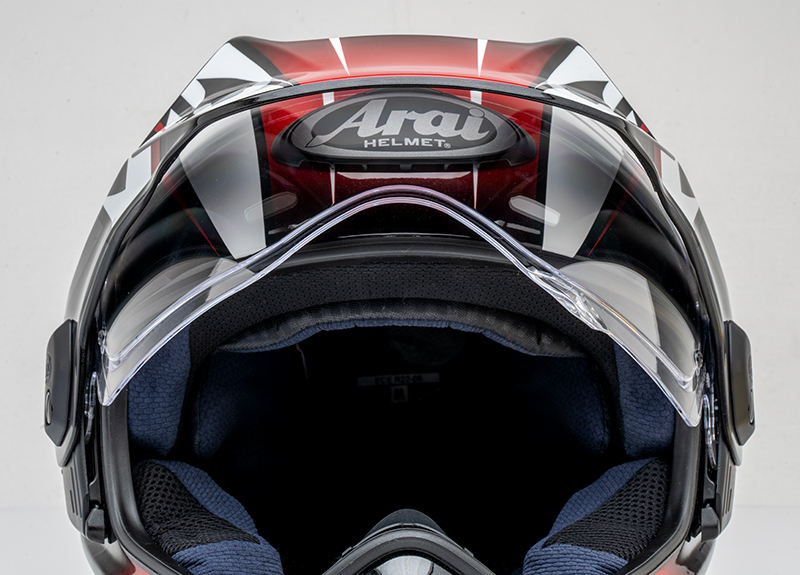
The other issue is that the helmet we tested had a truly below-average detent mechanism on the visor. Truth be told, this is rarely an Arai strong point, but on our helmet there was almost no resistance at any point. It was a weakness on the X4, so we are imagining that combining the visor mechanism with a removable peak makes life harder for the designers, but if our helmet, which was not a prototype, was anything to go by, then we can see it being a issue for some.
No helmet is perfect. We think the X5, overall, is a very impressive bit of kit, but often a product becomes judged on the basis of its weakest feature. We hope this doesn’t happen because, right now, one would have to take the view that the Tour-X5 is far and away the best adventure helmet money can buy.
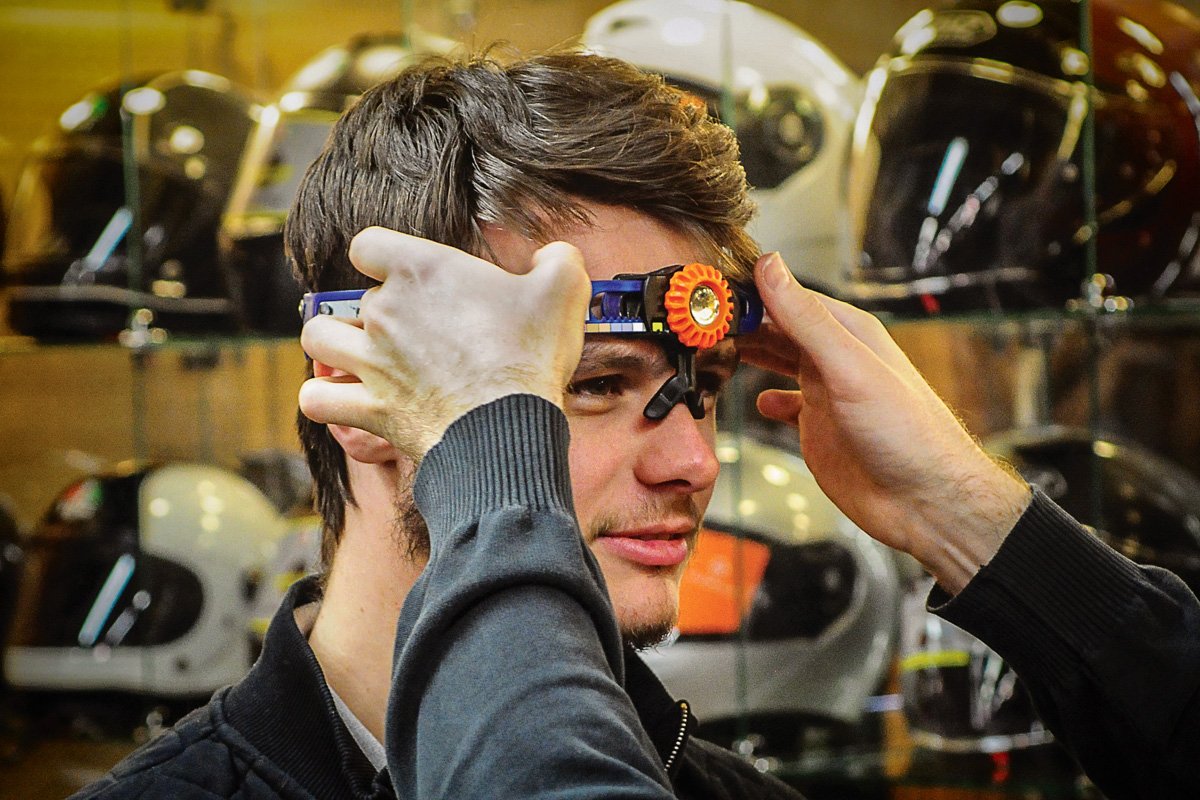
In the old days, bikers were told that they had either an Arai head shape or a Shoei head shape. And whilst this was an over-simplification, there was an element of truth at the time. And that's because, back then, there were really only two helmet in most proper bike shops. Arais and Shoeis.
Now Shoeis always had a slightly more oval fit; Arais a rounder one. So, if your head was too bulbous, too wide, or too round for a Shoei, by definition you had an Arai head.
It is still the case that Arais have a rounder internal shape than Shoei helmets. If you have a more oval-shaped head you will still be able to wear an Arai, but you may find that there will be gaps at the sides, gaps that cannot always be closed up by wearing a thicker headliner or thicker cheekpads. Not a major problem for most, but such helmet might move around a little more at speed, and the gaps might generate more wind noise.
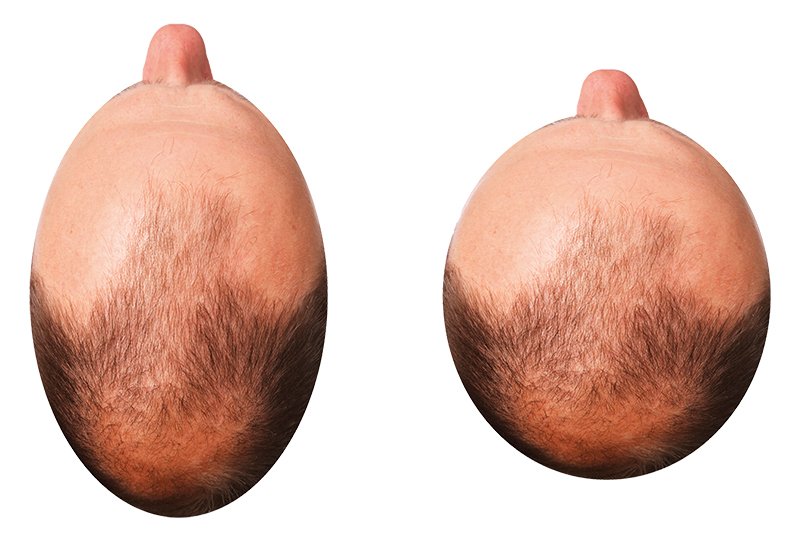
Here at Motolegends, custom fitting of helmets is one of our things. People come to us from all over the country, and even further afield, to get their helmets fitted properly. The good news is that there will be six different thicknesses of cheekpad for the Tour-X5, all of which will fit into every size. There will also be four different thicknesses of headliner for every helmet.
Clearly, we will not be the only people to carry all the cheekpads and headliners for the Tour-X5. But custom fitting helmets is something we do here many times a day, every day of the week. As I have said, it's one of our things. And if you're going to invest this much money in a helmet, we think it simply makes sense to get it properly fitted.

We've not ridden in this helmet, but we don't see what that would bring to the party. It's an Arai, we know that if it fits properly it's going to be comfortable. We know that, even if it is fitted perfectly, it still won't be as quiet as a Neotec. And we know that everything will work, and that nothing will fall off.
Somebody reporting on how the helmet performed when they rode it around the block a few times is somewhat irrelevant. How it performs for them will come down to their head shape, how well the helmet fits them, how tall they are, what bike they ride, what kind of screen the bike has, and so on.
In such reviews, you might get to see some nice pictures, or footage of somebody wearing the helmet at speed, but their findings are largely irrelevant.
Buy the X5 if it has the features you want. Buy it because the ‘adventure’ look is important to you. Buy it because you know you can live without a drop-down sun visor. Buy it because you can accept a bit of extra noise. Buy the X5 because you believe that Arai makes better quality and safer helmets than anybody else. Buy one if you can afford one. Importantly, buy one because it fits you well.
The most important thing, in our view, is to try one on. If you want further reassurance come and see us, and we’ll do a proper fitting. Heck, you can even take one out for a test ride. At this kind of price, you do not want to make a mistake. Because with prices starting at £600, that is going to hurt!
The Tour-X5 is due to be released early in the new year. It is expected that the helmet will be available initially in white and black. Other colourways will become available over the ensuing weeks and months. It may also be a few months before we have all the cheekpads and head liners that will allow us to do a custom fit. This having said, we will always do a custom fit after a helmet has been purchased; and, as ever, at no cost.
For more information and to buy online, click Arai Tour-X5 helmet.
Share this story

































































